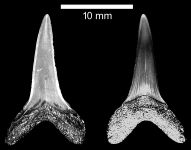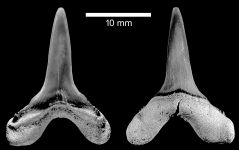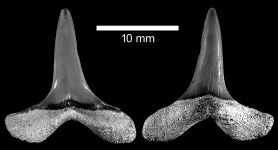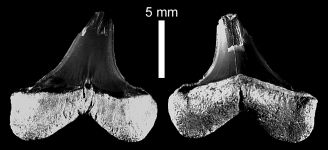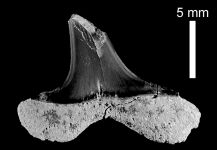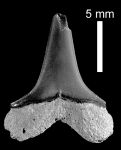Woellsteinia oligocaena
Reinecke, Stapf & Raisch, 2001
Classification: Elasmobranchii Lamniformes Mitsukurinidae
Reference of the original description
Die Selachier und Chimären des Unteren Meeressandes und Schleichsandes im Mainzer Becken (Rupelium, Unteres Oligozän). Palaeontos, 1, 1–73
Die Selachier und Chimären des Unteren Meeressandes und Schleichsandes im Mainzer Becken (Rupelium, Unteres Oligozän). Palaeontos, 1, 1–73
Types
Woellsteinia oligocaena
Holotype: SSN: 12WS1; Paratype: SSN: 12WS2; SSN: 12WS3; SSN: 12WS4; SSN: 12WS5;
Woellsteinia oligocaena
Holotype: SSN: 12WS1; Paratype: SSN: 12WS2; SSN: 12WS3; SSN: 12WS4; SSN: 12WS5;
Description:
Citation: Woellsteinia oligocaena Reinecke, Stapf & Raisch, 2001: In: Database of fossil elasmobranch teeth www.shark-references.com, World Wide Web electronic publication, Version 12/2025
Please send your images of "Woellsteinia oligocaena" to info@shark-references.com
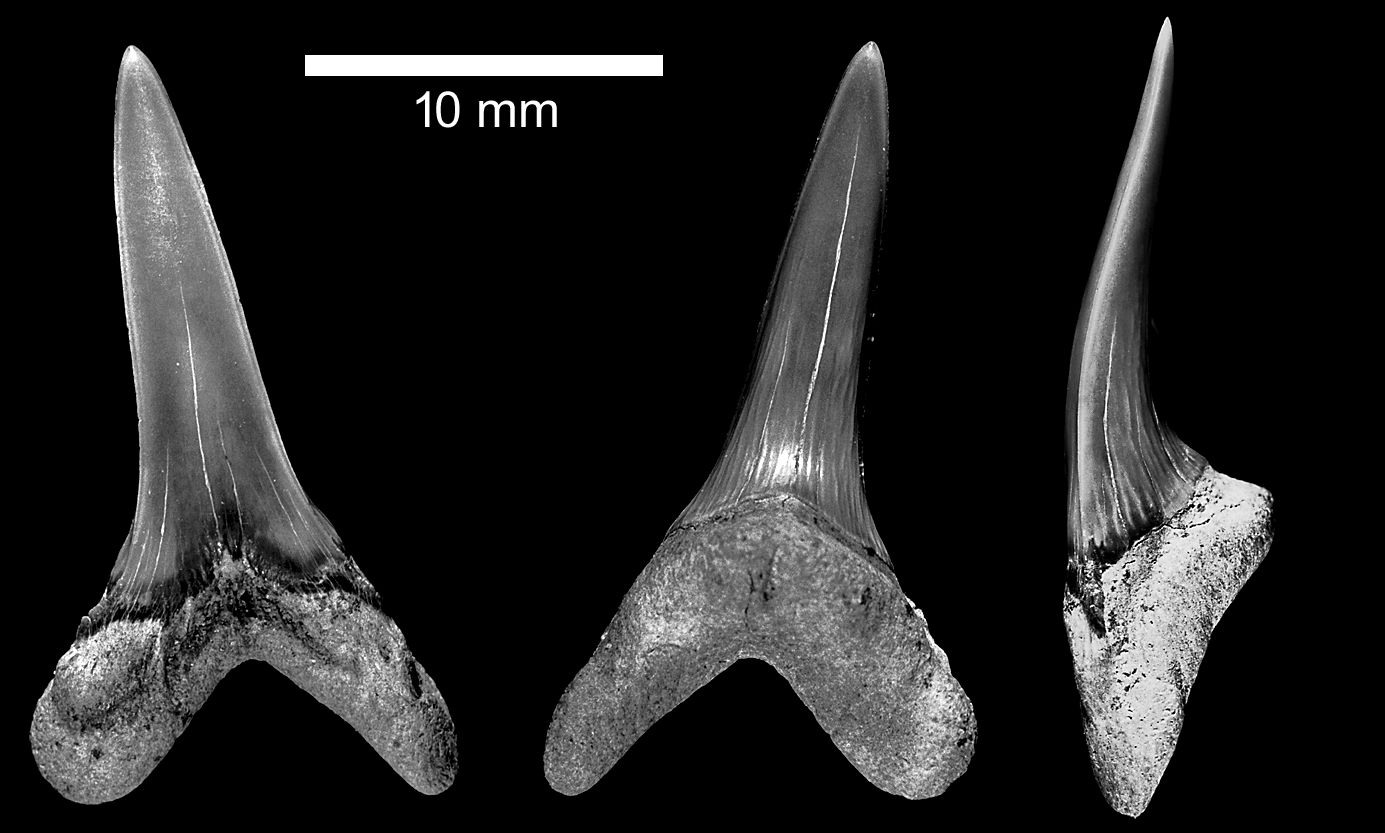
Woellsteinia oligocaena Reinecke, Stapf & Raisch, 2001; Holotype, Alzey Formation, Rupelian, early Oligocene; Sandpit "Müller & Schmidt", Wöllstein, Rheinland-Pfalz, Germany; Stapf Collection, Paleontological Museum Nierstein, SSN 12WS1; © T. Reinecke, Bochum

Woellsteinia oligocaena Reinecke, Stapf & Raisch, 2001; Holotype, Alzey Formation, Rupelian, early Oligocene; Sandpit "Müller & Schmidt", Wöllstein, Rheinland-Pfalz, Germany; Stapf Collection, Paleontological Museum Nierstein, SSN 12WS1; © T. Reinecke, Bochum
Description
1978 Anomotodon sp. – von der Hocht, p. 164 [3998]
1978 Anomotodon sp. – von der Hocht, p. 81 [3997]
1986 Anomotodon sp. – von der Hocht, p. 212-213 [4101]
1986 Anomotodon sp. – von der Hocht, p. 506 [2708]
Morphological characteristics after Reinecke et al. (2001), p. 48-52 [2034]:
Holotype:
Anterior tooth (?first anterior tooth of upper left jaw) with robust, distally inclined crown, which is only slightly bent in lingual direction. The Crown is narrowing rapidly above the base and again close to the tip. The cutting edges are sharp and smooth; they marginally extend along the half length of the root branches, where they have irregular notches. The labial crown face is smooth and slightly convex, with a flat central ridge occurring in the basal part. The sinusoidal root-crown junction shows an upright v-shaped indentation (axial depression) towards the crown tip. The lingual crown face is strongly convex and covered at its base by longitudinal folds. The folds are flexuous, change in relief along their length, and diminish in the upper third of the crown face. A 0.5 mm high dental rim accompanies the lingual crown base. The root is strong, with short, asymmetric lobes which meet at an angle of ca. 90 degrees. The distal lobe is well rounded and labio- lingually flattened at its extremity, and thicker than the mesial one which has a conical shape. At its upper labial face each root lobe bears a pronounced bulge. Between the bulges the root face deepens to form the v-shaped indentation mentioned above. The lingual protuberance of the root is well developed. The median groove on the lingual protuberance is flat and has a decentral foramen.
Paratype 1:
An upper lateral tooth (?first or second lateral tooth of the upper left jaw), with distally inclined asymmetric crown which continuously narrows toward the tip. The crown is thin and bladed. The cutting edges are thin, sharp and smooth, and extend to the heels as narrow, low ridges almost reaching the lateral margins of the root lobes. The labial crown face is smooth and sightly convex and features a flat axial depression near the crown base. The labial and lingual root- crown junction has a wavy has a wavy appearance. The lingual crown face is convex and covered in its basal part by flexuous longitudinal folds. These are less dense and flatter than in anterior teeth (see holotype and paratype 4). A narrow dental rim of rather constant height runs parallel to the lingual root-crown-junction. The root is very broad, the lobes are well-separated and ear-shaped, with rounded, labio-lingually flattened extremities. The lingual protuberance shows a slightly deepened groove with a foramen.
Paratypes 2 and 3:
Two lower lateral teeth of first files with upright, almost symmetrical crowns. On the heels the smooth cutting edges merge into thin, low enamel ridges which are irregularly notched at their extremities. The slightly convex labial crown face is smooth, whereas the much more convex lingual face is covered at its base by longitudinal, flexuous folds, very similar to that in anterior teeth. The folds reach up to halfcrown height. The lobes of the root are high and wide, and diverge by ca 100%. The smoothly curved basal edge of the root reminds the graph of a sinus function. The extremities of the root lobes are labio-lingually flattened. The groove on the lingual protuberance 1S noticeable.
Paratype 4:
A lower left anterior tooth with an almost symmetrical crown which is only slightly inclined distally, but markedly bent to the rear. The thin and sharp cutting edges extend from the crown tip to the heels, approaching the subvertical margins of the root lobes. The labial crown face is convex near the crown tip, but almost flat near the base. The lower third of the face bears an axial ridge. Below that ridge the root-crown junction is displaced apically, forming a inverted V. The lingual face is strongly convex and shows many logitudinal folds, which fade at half crown height. Compared to lateral teeth, the root is rather low and slender. The lobes are well separated and meet at an angle of 90. The distal lobe is thicker than the mesial lobe and flattened labio-lingually in its basal part. The mesial and distal labial crown base passes into two weak bulges situated on the upper face of the root lobes. The lingual protuberance appears to be abraded and hence the groove is barely observable.
Paratype 5:
A lateral tooth of the lower jaw with a symmetrical, upright crown and broad base. The crown tip is broken off. The cutting edges are smooth and continuous to the heels, where they end abruptly close to the rounded margins of the root lobes. In occlusal view, the cutting edges on the heels are bent in lingual direction. The labial crown face is slightly convex, smooth and has short axial ridge at its base. The root-crown junction is almost rectilinear, with a weak axial indentation toward the crown tip. The lingual face is more convex and shows few longitudinal folds near the crown base. The symmetrical root is strong and rather high. It has two well separated, blunt lobes with rounded shape. The lingual protuberance is low and bears a flat groove.
Heterodonty:
As the genus Woellsteinia has no extant species, heterodonty can be inferred by comparison with extant genera of the Mitsukurinidae and Odontaspididae only. The only extant representative of the Mitsukurinidae is Mitsukurina owstoni JORDAN, 1898, CAPPETTA (1980a: plate 11) figured the dentition of a male, measuring 2.50 m in total length, which comprises 3 anterior and 11 lateral teeth in the upper (half)jaw, and 1 parasymphyseal, 3 anterior and 10 lateral teeth in the lower jaw. In the tooth formulae of two individuals (P. 105-106) including the figured one, however, he reported only 2 anterior, but 11 resp. 9 lateral teeth to occur in the lower jaw. The dentition of Mitsukurina owstoni, displayed by COMPAGNO (1984: 223), is interpreted to have 3 anterior and 10 lateral teeth in the upper jaw and 1 parasymphyseal, 3 anterior and 8 lateral teeth in the lower jaw. DUFFY (1997) repotted 3 anterior and 8-11 lateral teeth in the upper halfjaw and 3 anterior and 8-10 lateral teeth in the lower halfjaw of two female and one male specimen. In addition there are 6-10 posterior tenth which are significantly less high than lateral teeth and have flattened crowns. It can be therefore assumed that there are always three anterior teeth in both jaws, whereas the number of laterals and posteriors varies.
As discussed below, the artificial tooth set displayed in plates 24 and 25 is uncertain as regards the number of dental files, in particular of the laterals. The principal characteristics of the dignathic disjunct heterodonty, however, are well understood because of the significant number of teeth studied. Because of its large height/width-ratio in conjunction with the asymmetric shape of the root, the holotype is likely to represent the first anterior file of the upper jaw. Correspondingly, the teeth shown in plate 27, fig. b and c can be assigned to the second upper anterior file, because they are wider and more upright than the first anterior tooth, but still have markedly asymmetric root lobes and - in contrast to lower anterior teeth - a distally bent upper cusp. The third anterior tooth (plate 25, third upper left) is characterized by a distally inclined crown with concave mesial cutting edge, which is mirror image to the crown asymmetry of the second anterior tooth. This relationship is inferred from upper anterior teeth of Mitsukurina owstoni (CAPPETTA, 1980a: plate 11, fig. B2 and B3) and of some odontaspidid taxa (C-g. Carcharias acutissimus, plate 11; Carcharias cuspidatus, plate 17). The studied material does not contain teeth which can be assigned to an intermediate file.
Teeth of the first upper lateral files have a bladed, upright crown with wide heels resting on a wide, bilobed root. Only in the first lateral files the distal inclination of the crown increases and then remains almost unchanged towards the commissure, except for the very last lateral file(s). In more distally placed upper lateral teeth, the root and heels decrease in width relative to the crown base and the teeth assume a more triangular shape. Such a trend towards more compact lateral teeth is also noticeable in the laterals of Mitsukurina owstoni JORDAN, 1898, but is not observed within the genus Anomotodon, e.g. Anomotodon sheppeyensis (CASIER, 1966). Between the first and second upper lateral tooth displayed in plate 25, there are likely to be one or two additional files which were not detected in the studied material.
The anterior teeth of the lower jaw show less differences in shape than their counterparts in the upper jaw. A very robust, narrow, symmetrical tooth (plate 24, first upper left with broken crown tip) may represent the first anterior of a large individual, The second and third lower anteriors are almost symmetrically developed (plate 24, second upper left; plate 26, fig. b), resp. show a weak distal inclination of the crown and asymmetric root lobes (plate 24, third upper left; plate 26, fig. a). Similar to the upper laterals, the first files of lower lateral teeth (plate 24, fourth, fifth and sixth upper left tooth; plate 26, fig. c and d) have wide heels and ear-shaped root lobes. Their crowns are upright and not distally inclined. Towards the commissure the crowns tend to be triangular in shape and the height of the root increases relative to crown height. The studied material does not contain parasymphyseal teeth.
1978 Anomotodon sp. – von der Hocht, p. 164 [3998]
1978 Anomotodon sp. – von der Hocht, p. 81 [3997]
1986 Anomotodon sp. – von der Hocht, p. 212-213 [4101]
1986 Anomotodon sp. – von der Hocht, p. 506 [2708]
Morphological characteristics after Reinecke et al. (2001), p. 48-52 [2034]:
Holotype:
Anterior tooth (?first anterior tooth of upper left jaw) with robust, distally inclined crown, which is only slightly bent in lingual direction. The Crown is narrowing rapidly above the base and again close to the tip. The cutting edges are sharp and smooth; they marginally extend along the half length of the root branches, where they have irregular notches. The labial crown face is smooth and slightly convex, with a flat central ridge occurring in the basal part. The sinusoidal root-crown junction shows an upright v-shaped indentation (axial depression) towards the crown tip. The lingual crown face is strongly convex and covered at its base by longitudinal folds. The folds are flexuous, change in relief along their length, and diminish in the upper third of the crown face. A 0.5 mm high dental rim accompanies the lingual crown base. The root is strong, with short, asymmetric lobes which meet at an angle of ca. 90 degrees. The distal lobe is well rounded and labio- lingually flattened at its extremity, and thicker than the mesial one which has a conical shape. At its upper labial face each root lobe bears a pronounced bulge. Between the bulges the root face deepens to form the v-shaped indentation mentioned above. The lingual protuberance of the root is well developed. The median groove on the lingual protuberance is flat and has a decentral foramen.
Paratype 1:
An upper lateral tooth (?first or second lateral tooth of the upper left jaw), with distally inclined asymmetric crown which continuously narrows toward the tip. The crown is thin and bladed. The cutting edges are thin, sharp and smooth, and extend to the heels as narrow, low ridges almost reaching the lateral margins of the root lobes. The labial crown face is smooth and sightly convex and features a flat axial depression near the crown base. The labial and lingual root- crown junction has a wavy has a wavy appearance. The lingual crown face is convex and covered in its basal part by flexuous longitudinal folds. These are less dense and flatter than in anterior teeth (see holotype and paratype 4). A narrow dental rim of rather constant height runs parallel to the lingual root-crown-junction. The root is very broad, the lobes are well-separated and ear-shaped, with rounded, labio-lingually flattened extremities. The lingual protuberance shows a slightly deepened groove with a foramen.
Paratypes 2 and 3:
Two lower lateral teeth of first files with upright, almost symmetrical crowns. On the heels the smooth cutting edges merge into thin, low enamel ridges which are irregularly notched at their extremities. The slightly convex labial crown face is smooth, whereas the much more convex lingual face is covered at its base by longitudinal, flexuous folds, very similar to that in anterior teeth. The folds reach up to halfcrown height. The lobes of the root are high and wide, and diverge by ca 100%. The smoothly curved basal edge of the root reminds the graph of a sinus function. The extremities of the root lobes are labio-lingually flattened. The groove on the lingual protuberance 1S noticeable.
Paratype 4:
A lower left anterior tooth with an almost symmetrical crown which is only slightly inclined distally, but markedly bent to the rear. The thin and sharp cutting edges extend from the crown tip to the heels, approaching the subvertical margins of the root lobes. The labial crown face is convex near the crown tip, but almost flat near the base. The lower third of the face bears an axial ridge. Below that ridge the root-crown junction is displaced apically, forming a inverted V. The lingual face is strongly convex and shows many logitudinal folds, which fade at half crown height. Compared to lateral teeth, the root is rather low and slender. The lobes are well separated and meet at an angle of 90. The distal lobe is thicker than the mesial lobe and flattened labio-lingually in its basal part. The mesial and distal labial crown base passes into two weak bulges situated on the upper face of the root lobes. The lingual protuberance appears to be abraded and hence the groove is barely observable.
Paratype 5:
A lateral tooth of the lower jaw with a symmetrical, upright crown and broad base. The crown tip is broken off. The cutting edges are smooth and continuous to the heels, where they end abruptly close to the rounded margins of the root lobes. In occlusal view, the cutting edges on the heels are bent in lingual direction. The labial crown face is slightly convex, smooth and has short axial ridge at its base. The root-crown junction is almost rectilinear, with a weak axial indentation toward the crown tip. The lingual face is more convex and shows few longitudinal folds near the crown base. The symmetrical root is strong and rather high. It has two well separated, blunt lobes with rounded shape. The lingual protuberance is low and bears a flat groove.
Heterodonty:
As the genus Woellsteinia has no extant species, heterodonty can be inferred by comparison with extant genera of the Mitsukurinidae and Odontaspididae only. The only extant representative of the Mitsukurinidae is Mitsukurina owstoni JORDAN, 1898, CAPPETTA (1980a: plate 11) figured the dentition of a male, measuring 2.50 m in total length, which comprises 3 anterior and 11 lateral teeth in the upper (half)jaw, and 1 parasymphyseal, 3 anterior and 10 lateral teeth in the lower jaw. In the tooth formulae of two individuals (P. 105-106) including the figured one, however, he reported only 2 anterior, but 11 resp. 9 lateral teeth to occur in the lower jaw. The dentition of Mitsukurina owstoni, displayed by COMPAGNO (1984: 223), is interpreted to have 3 anterior and 10 lateral teeth in the upper jaw and 1 parasymphyseal, 3 anterior and 8 lateral teeth in the lower jaw. DUFFY (1997) repotted 3 anterior and 8-11 lateral teeth in the upper halfjaw and 3 anterior and 8-10 lateral teeth in the lower halfjaw of two female and one male specimen. In addition there are 6-10 posterior tenth which are significantly less high than lateral teeth and have flattened crowns. It can be therefore assumed that there are always three anterior teeth in both jaws, whereas the number of laterals and posteriors varies.
As discussed below, the artificial tooth set displayed in plates 24 and 25 is uncertain as regards the number of dental files, in particular of the laterals. The principal characteristics of the dignathic disjunct heterodonty, however, are well understood because of the significant number of teeth studied. Because of its large height/width-ratio in conjunction with the asymmetric shape of the root, the holotype is likely to represent the first anterior file of the upper jaw. Correspondingly, the teeth shown in plate 27, fig. b and c can be assigned to the second upper anterior file, because they are wider and more upright than the first anterior tooth, but still have markedly asymmetric root lobes and - in contrast to lower anterior teeth - a distally bent upper cusp. The third anterior tooth (plate 25, third upper left) is characterized by a distally inclined crown with concave mesial cutting edge, which is mirror image to the crown asymmetry of the second anterior tooth. This relationship is inferred from upper anterior teeth of Mitsukurina owstoni (CAPPETTA, 1980a: plate 11, fig. B2 and B3) and of some odontaspidid taxa (C-g. Carcharias acutissimus, plate 11; Carcharias cuspidatus, plate 17). The studied material does not contain teeth which can be assigned to an intermediate file.
Teeth of the first upper lateral files have a bladed, upright crown with wide heels resting on a wide, bilobed root. Only in the first lateral files the distal inclination of the crown increases and then remains almost unchanged towards the commissure, except for the very last lateral file(s). In more distally placed upper lateral teeth, the root and heels decrease in width relative to the crown base and the teeth assume a more triangular shape. Such a trend towards more compact lateral teeth is also noticeable in the laterals of Mitsukurina owstoni JORDAN, 1898, but is not observed within the genus Anomotodon, e.g. Anomotodon sheppeyensis (CASIER, 1966). Between the first and second upper lateral tooth displayed in plate 25, there are likely to be one or two additional files which were not detected in the studied material.
The anterior teeth of the lower jaw show less differences in shape than their counterparts in the upper jaw. A very robust, narrow, symmetrical tooth (plate 24, first upper left with broken crown tip) may represent the first anterior of a large individual, The second and third lower anteriors are almost symmetrically developed (plate 24, second upper left; plate 26, fig. b), resp. show a weak distal inclination of the crown and asymmetric root lobes (plate 24, third upper left; plate 26, fig. a). Similar to the upper laterals, the first files of lower lateral teeth (plate 24, fourth, fifth and sixth upper left tooth; plate 26, fig. c and d) have wide heels and ear-shaped root lobes. Their crowns are upright and not distally inclined. Towards the commissure the crowns tend to be triangular in shape and the height of the root increases relative to crown height. The studied material does not contain parasymphyseal teeth.
Remarks
shark-references Species-ID=7517;
shark-references Species-ID=7517;
References

Climate cooling and clade competition likely drove the decline of lamniform sharks. Proceedings of the National Academy of Sciences of the United States of America, 116(41), 20584–20590
DOI: 10.1073/pnas.1902693116

Die zeitliche Entwicklung der Chondrichthyer-Faunen der Selztal-Gruppe (Rupelium, U.Oligozän) des Mainzer Beckens (SW-Deutschland) - Ursachen und Potenziale. Mainzer naturwissenschaftliches Archiv, 48, 155–170

Die Selachier und Chimären des Unteren Meeressandes und Schleichsandes im Mainzer Becken (Rupelium, Unteres Oligozän). Palaeontos, 1, 1–73

Climate cooling and clade competition likely drove the decline of lamniform sharks. Proceedings of the National Academy of Sciences of the United States of America, 116(41), 20584–20590
DOI: 10.1073/pnas.1902693116

Die zeitliche Entwicklung der Chondrichthyer-Faunen der Selztal-Gruppe (Rupelium, U.Oligozän) des Mainzer Beckens (SW-Deutschland) - Ursachen und Potenziale. Mainzer naturwissenschaftliches Archiv, 48, 155–170

Die Selachier und Chimären des Unteren Meeressandes und Schleichsandes im Mainzer Becken (Rupelium, Unteres Oligozän). Palaeontos, 1, 1–73








